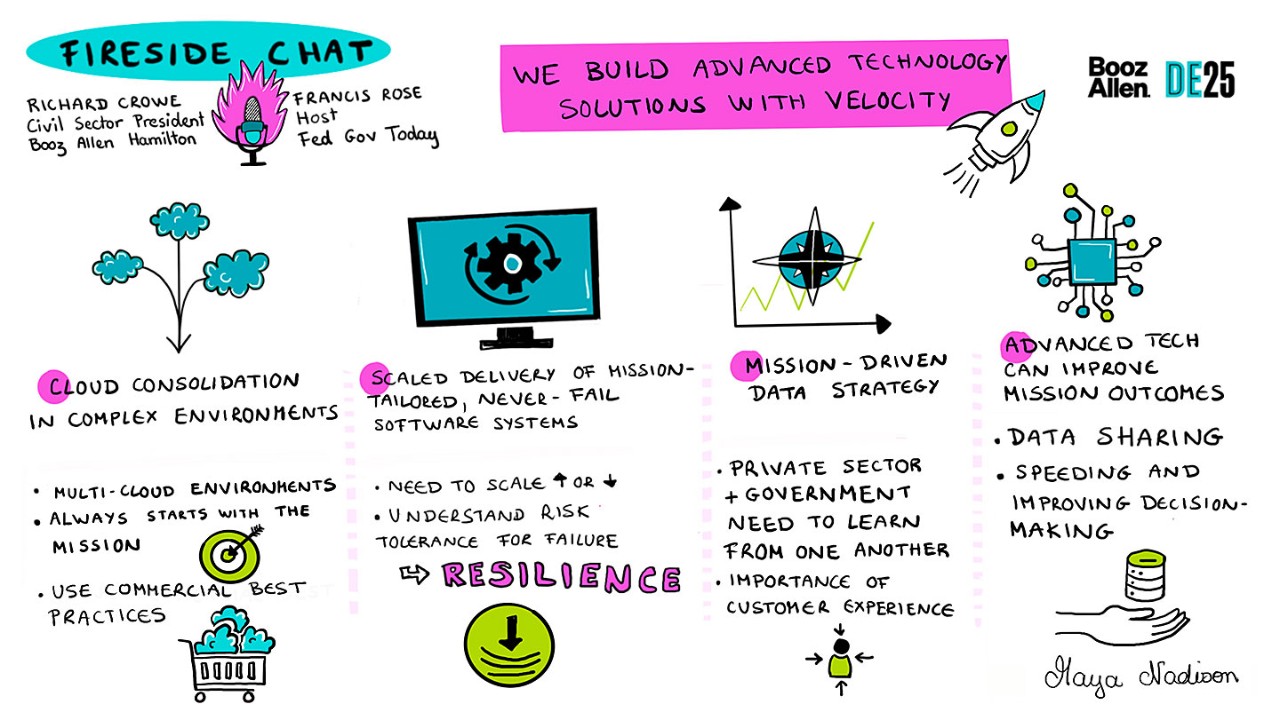
Cloud strategies that drive mission impact
Cloud is no longer the exception in government—it’s the expectation. Across federal agencies, cloud fuels faster services, smarter operations, and stronger security. It’s not just a technology shift—it’s a mission imperative.
Over the past decade, I’ve had a front-row seat to the federal government’s cloud evolution, partnering with agencies on more than 1,000 cloud computing projects. By combining deep mission insight with fluency in data science and emerging technology, we help agencies unlock the full power of their data to drive real outcomes.
From mission-driven data strategy to AI, from resilient software delivery to zero trust, we don’t just help clients move to the cloud—we help them design for it. By weaving cloud-native principles and patterns into every layer of the tech stack, we are redefining what’s possible for federal missions. What we have learned drives successful cloud transformation, aligning technology with mission needs and building trust through resilience and user-centered design.
 Key insights on cloud as an accelerator for government, as captured by graphical sketch artist, Maya Nadison, at the DE25: Driving Outcomes Through Data Event in Spring 2025.
Key insights on cloud as an accelerator for government, as captured by graphical sketch artist, Maya Nadison, at the DE25: Driving Outcomes Through Data Event in Spring 2025.
Data Strategy Starts with Mission, Not Technology: Cloud as the Scalable Engine for Actionable Insights
When agencies are considering new technologies, especially cloud, the first priority shouldn’t be the product or provider. It should be the mission. The right starting point is always the question: What problem are we trying to solve? The answer must directly inform the data strategy; without this clarity, even the best technology risks missing the mark.
Cloud enables secure, real-time access to data, ensuring mission leaders have the insights they need to make informed decisions. When agencies begin to treat their data like a product, it allows for secure, convenient consumption so that other approved entities and mission teams can access, understand, and act on mission-advancing insights.
While data strategy may sound basic in the era of AI and advanced cloud platforms, it’s anything but optional—it's the foundation. A mission-driven data strategy ensures that data collection, management, and analytics are directly tied to an agency’s core objectives, so that every data action drives real operational outcomes.
Tech Impact: Booz Allen builds and operates some of the government's most critical data and intelligence solutions. Take, for instance, our work at the Department of Veterans Affairs (VA) in support of migrating away from a 50-year-old mainframe system that was central to processing veterans’ benefits and services. Rather than beginning with a specific cloud platform or toolset, Booz Allen began by asking: What are the VA’s critical mission needs? The answer: enable faster, more accurate access to veterans’ data, improve claims processing, and reduce reliance on aging infrastructure that risks downtime or failure. Guided by these mission goals, Booz Allen led the development of a cloud-native data platform that replicated over 2.5 million daily transactions from the legacy mainframe to a modern, scalable environment. We completed over 30 software deployments—all without disrupting business operations. The team used APIs, event-driven architecture, and cloud-native microservices to ensure real-time access and resilience.
The result? A future-ready foundation that directly improved service delivery for veterans—faster benefits processing, less downtime, and a dramatically lower risk of failure during critical operations. The cloud wasn’t the starting point—it was the tech enabler.
Civil Missions Demand Resilience — Cloud Delivers It
For civil agencies, resilience isn’t a bonus, it’s the non-negotiable baseline. Whether it’s delivering healthcare, securing borders, managing benefits, or protecting financial systems—federal missions must operate without interruption, under extreme load, in the face of constant cyber threats, and across distributed environments. These are “never-fail” systems where downtime equals risk—to public safety, national security, or citizen trust.
Traditional, siloed IT systems weren’t built for today’s pace—or today’s threats. Manual patching, legacy code, and aging infrastructure create brittle environments where failure is only a matter of time. Cloud infrastructure flips the script. It embeds resilience at every layer—offering scalable, redundant systems that respond in real time to disruption. With automated failover, continuous backups, and built-in elasticity, cloud minimizes downtime and protects mission-critical data from loss.
Tech Impact: The U.S. Department of the Treasury, whose core mission is to safeguard the nation's financial backbone demands not just secure infrastructure, but continuous, resilient operations. When Treasury set out to build something bold—a FedRAMP High-authorized, agency-owned cloud designed to support the full weight of its mission—Booz Allen delivered. Our team architected and implemented a platform capable of hosting the agency’s most sensitive mission workloads. In just six months, Booz Allen built the Workplace Community Cloud-High (WC2H): a resilient, high-impact hybrid-cloud environment compliant with 421 FedRAMP requirements, enabling the Treasury to host secure public-facing and mission applications alongside sensitive data, such as Federal Tax Information (FTI). All while facilitating 99.99% uptime and increased security and reliability for Treasury’s public-facing websites.
The result? A digital infrastructure that supports critical financial data delivery and secures Treasury’s mission-critical systems—at speed and scale. WC2-H enabled Treasury to move beyond traditional on-prem clouds to secure, scalable platforms built for high security missions. We doubled the size of the cloud environment, improved performance through automated patching and container management, and cut migration timelines in half with streamlined provisioning. Now operating across multiple cloud providers, WC2-H acts as critical digital infrastructure supporting financial data delivery and a wide range of enterprise mission applications with centralized governance, built-in resilience, and top-tier customer service.
AI at Cloud Speed: Advanced Technology for Mission Outcomes
AI is important for cloud because it helps turn large amounts of data into useful insights and faster decisions. While cloud gives organizations the space and power to store and process data, AI makes that information smart—finding patterns, making predictions, and automating tasks.
AI supercharges the cloud by making it smarter, faster, and more adaptive. It automates data processing, enhances powerful analytics, and enables intelligent services—all at scale—turning cloud infrastructure into a powerful engine for insight and mission execution.
In the article “AI & Everything,” Booz Allen President and CEO Horacio Rozanski correctly pointed out that AI’s true potential will be unleashed when it is paired with other technologies to drive transformational outcomes. Together, AI and cloud allow agencies to respond quickly, work more efficiently, and get more value from their technology. Whether it's detecting threats, improving services, or managing resources, AI helps cloud systems do more, and do it better.
Tech Impact: The Department of Veterans Affairs handles millions of disability claims each year—which are lengthy, complex, and include thousands of pages of documentation. To help claims processors review and adjudicate claims faster and more accurately, Booz Allen developed and deployed an AI-powered document processing solution hosted in a secure cloud environment. The system used natural language processing (NLP) and machine learning (ML) to automatically extract relevant information from unstructured documents, prioritize cases, and assist human reviewers by flagging key data points.
The result? By integrating this AI capability with AWS cloud infrastructure, the VA was able to enable 9× efficiency to claims processors searching for specific data points in veteran documentation; make the completion of required paperwork related to exposure to toxins far less time-consuming, saving the VA up to 675,000 hours a year; and automate time-intensive, highly manual processes with claim processing workflows to reduce the average days to complete veteran claims. The cloud enabled this AI solution to scale quickly and handle high volumes of secure data—ensuring the system evolves alongside the mission.
Solving for Cloud Complexity through Cloud Consolidation
Federal environments are often burdened by overlapping cloud services, legacy on-prem systems, and disconnected tech stacks. In a world of multicloud complexity and legacy technical debt, federal leaders need clarity, not chaos. Cloud consolidation efforts help to unify this complexity into streamlined, secure, and cost-effective platforms—without losing mission specificity. That includes migrating workloads to centralized environments, implementing cross-domain orchestration, and enforcing consistent cloud governance.
Booz Allen leverages human-centered design to create mission-tailored cloud solutions that are not only technically excellent, but also easy and straightforward to use because the stakes are too high for complexity or confusion to get in the way.
Tech Impact: Booz Allen supported a major federal public health organization in consolidating siloed data environments into a unified, cloud-based analytics and collaboration platform. Previously, data systems were distributed across multiple programs, making it difficult to share timely information across federal, state, and local partners. Booz Allen helped design and deploy a centralized cloud-native environment that integrated surveillance data, dashboards, and reporting tools into a single, scalable infrastructure.
The result? Faster data sharing, consistent governance, and real-time decision making. The platform, built on secure AWS infrastructure, allowed the agency to rapidly launch mission-specific dashboards. By unifying infrastructure and analytics under one cloud umbrella, the organization improved its ability to collaborate across jurisdictions, respond to emerging threats, and build a more agile, resilient public health ecosystem.
Partnering Across Industry to Strengthen Government Cloud Adoption
We do not go at it alone to accelerate outcomes for America. We team with industry leaders like Amazon Web Service (AWS), Microsoft Azure, and Google Cloud to accelerate adoption across federal civilian agencies. Through these partnerships, we work together to integrate commercial cloud innovation with mission-critical requirements for federal civilian agencies. Our joint efforts ensure agencies get resilient, scalable, and secure solutions.
Cloud isn’t a future aspiration—it’s the operational foundation for a successful, modern government. Federal agencies that embrace cloud are better equipped to deliver services, defend against cyber threats, and adapt to the future. At Booz Allen, we bring the strategy, partnerships, and the technical expertise to help agencies not just migrate—but transform. If you are ready to turn cloud into a mission advantage, let’s build what’s next—together.
Commercial-grade services—synced to your mission. Learn more about Booz Allen's cloud solutions.
Richard Crowe is president of Booz Allen's civil business and a member of our leadership team. This article is one of several in our Data-Enabled Missions Tech Talk Series.
Learn more about how we are accelerating Data-Enabled Missions.


